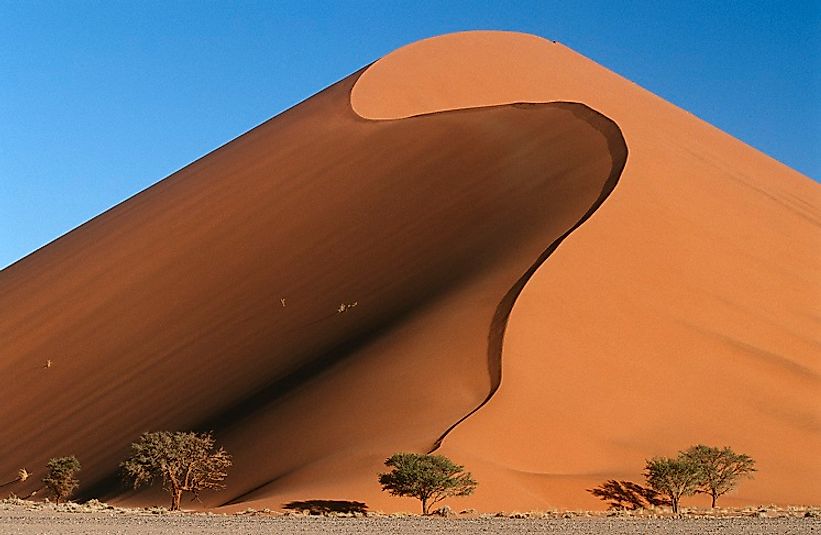Where Is The Namib Desert?

The Namib desert is a unique desert that extends to reach along the coastlines of Namibia. It has a unique array of flora and fauna, and, despite its barren landscape, is full of biodiversity and other natural surprises for tourists.
5. Description
The Namib Desert is a coastal desert primarily located in Namibia, Africa, and is one of the largest coastal deserts in the world, according to the United Nations Educational, Scientific and Cultural Organization (UNESCO). The desert’s surface area is 80,900 square kilometers,and it extends inland from the Atlantic Ocean to cover parts of Angola and South Africa as well. Along the arid South Atlantic Ocean shoreline, the Namib Desert stretches 1,200 miles. The surface of the Namib Desert is characterized by shifting crescent-shaped sand dunes, barren gravel plains, and rough mountains. According to the World Wild Fund for Nature (WWF), some of the desert’s sand dunes are over 300 meters in height, placing them among the tallest in the world.
4. Historical Role
The Namib Desert is believed to be one of the oldest deserts in the world, having existed for over 55 million years. The earliest evidence of humans living in the desert has been dated to during the late Stone Age era. Today, these peoples' rock paintings and engravings are to be seen at various sites throughout the Namib Desert. Stone circles, pottery, and tools of bygone eras have also been discovered there. The most famed of the paintings are the “White Lady” painting, seen near a rocky cliff next to the Brandberg Mountains. There also are rock engravings at Twyfelfontein of such animals as rhinoceroses and ocher-painted elephants, ostriches, and giraffes. There have also been human and animal footprint fossils discovered at Twyfelfontein, according to UNESCO. These paintings and engravings shed a great deal of light on rituals and practices of the hunter-and-gatherers that have lived in southern Africa for at least 2,000 years.
3. Modern Significance
Namibia receives over one million tourists yearly, according to the World Bank. Most of American and European tourists visiting the country go there due to the allures of Namib Desert tourism. The Namib Desert is one of the desert-loving tourists’ destinations where visitors go to engage in activities like hot air ballooning, climbing the sand dunes, and quad bike riding. Along the coastline where the desert stretches, there are mining and prospecting companies, an important activity in a country whose mining sector provides 25 percent of the nation's revenue, according to the Africa Wildlife Foundation. That makes mining the largest contributor to Namibia’s economy of any sector. Tungsten, diamond, salt, and uranium are mined within the Namib Desert, much of which is extracted by some of the major mining conglomerates of the world, such as the Rio Tinto Group who leads all other companies operating in Namibia in the field of uranium mining.
2. Habitat and Biodiversity
Annually, much of the Namib Desert receives less than 10 millimeters of rain, making the dense coastal fog it receives the primary water source in many areas, according to UNESCO. Daylight temperatures at the desert can be as high as 60 degrees centigrade, and at night fall below 0 degrees centigrade, according to the WWF. Still, this harsh ecosystem is able to sustain 3,500 plant species, half of which are endemic. There are diverse succulents, like the Welwitschia Mirabilis plants found there. According to the WWF, these Welwitschia mirabilis have only 2 leaves, but can have a lifespan of over 1,000 years. Parts of the Namib Desert are dotted with Savanna Woodlands, and these are largely dominated by acacia and camel-thorn tree species. These ecosystem have an abundance of fauna wildlife as well, including the unique Desert elephants (with larger feet than other elephants and able to survive on vegetation-derived moisture alone), Mountain zebras, Gemsbok antelopes, Short-eared elephant shrews, Grant’s golden moles, Karoo bustard birds, and the venomous Peringuey's adder snakes. The Namib Desert also has the elusive Desert lions which have adapted to survive there. Also native to this environment is the Fog-stand beetle, whose conspicuous shell is able to harvest fog to sustain its hydration.
1. Environmental Threats and Territorial Disputes
Even though it is largely a protected region, there are still many ongoing threats to the Namib Desert's ecosystems. Off-road driving on the gravel plains leaves tire marks that may last for over 40 years because the minimal levels of rain experienced there can’t erase them. These marks damage the slow growing lichen fields, and lichens take time to replenish. This type of damage is caused largely by mining vehicles on prospecting missions in the desert, according to the WWF. Mining, illegal plant harvesting, and other forms of unsustainable land use also destabilize the Namib Desert and its fragile ecosystems. According to the Namibian Coast Conservation and Management Project, coastal biodiversity within the desert also faces threats from mining related pollution, excessive water exploitation, climate change, land reclamation for mining or industrial development, overfishing, and the introduction of invasive species for mariculture development along and just off the desert's shores.











